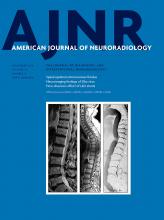We thank our colleagues for their comments about our recent article, “Blood Flow Mimicking Aneurysmal Wall Enhancement: A Diagnostic Pitfall of Vessel Wall MRI Using the Postcontrast 3D Turbo Spin-Echo MR Imaging Sequence.”1
Black-blood techniques such as motion-sensitized driven equilibrium or delay alternating with nutation for tailored excitation (DANTE) offer new perspectives for a better understanding of the nature of intracranial aneurysm enhancement. In our experience, flow-related artifacts are frequently encountered using the postcontrast 3D-TSE sequence for a wide range of incidental aneurysms (at the center of the aneurysmal cavity but also in contact with the wall of the aneurysm). It is now clear that the slow-flowing blood near the aneurysmal wall may represent all or part of the visible enhancement using conventional 3D-TSE sequences. Such findings raise the question of the relevance of this parameter for the management of asymptomatic patients.
The relationship among contrast enhancement on 3D-TSE, slow-flowing blood, low shear stress, and aneurysmal instability is poorly reported and is still speculative. In addition, studies with a long-term follow-up and/or histologic correlation are lacking in the literature. Thus, it appears difficult to assume that the enhancement related to slow-flowing blood and that of the aneurysmal wall itself are both related to inflammation/instability. Quite on the opposite, we think that it would be interesting to independently analyze each component of the enhancement visible on conventional 3D-TSE, including slow-flowing blood. Such an approach would allow us to identify patients in whom the slow-flowing blood is predominant versus those in whom the addition of a black-blood technique has little or no influence on the enhancement already visible on conventional sequences (and therefore potentially related to a “true” enhancement of the wall).
A better understanding of the factors likely to promote slow-flowing blood near the aneurysmal wall (such as the size of the aneurysm?) also appears important. In our opinion, the real ability of the 3D-TSE sequence to assess arterial wall inflammation remains uncertain because we cannot formally exclude residual slow-flowing blood (even including the additional black-blood technique). Further studies are required to evaluate alternative/complementary MR sequences less sensitive to flow artifacts and with a higher spatial resolution.
We hope that this discussion will encourage other teams to continue evaluating the circumferential wall enhancement of intracranial aneurysms, which remains a particularly complex entity.
Reference
- 1.↵
- © 2018 by American Journal of Neuroradiology











